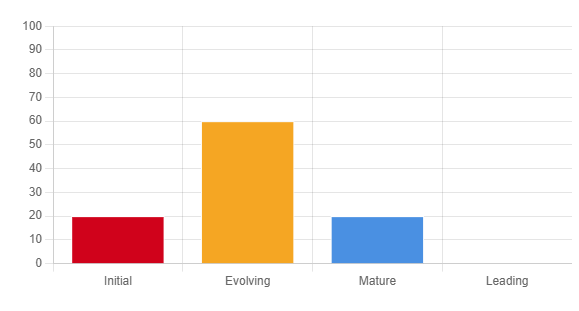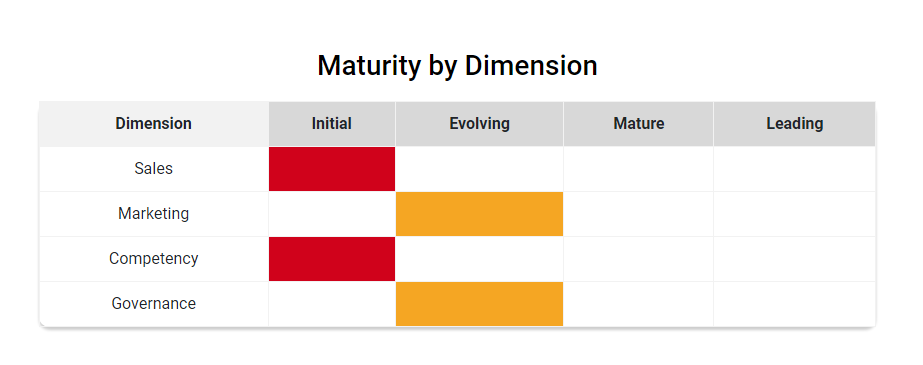In this blog, I’ll introduce a practical partnership maturity model that you can use to perform a diagnostic.
As you already know, running a partnership or alliance in tech needs a variety of things to come together, viz. marketing, sales, solution building, competency development, relationship management, leadership alignment etc.
However, while executing in the trenches, it’s difficult to assess the health of your partnership without an overarching framework that allows you to do so.
Therefore, I created a simple and practical framework that covers governance, marketing, sales, and technical expertise.
The Partnership Maturity Model Has 4 Levels
To balance comprehensiveness and simplicity of interpretation, there are 4 levels of maturity in the model:

(the y-axis above is just the % of all respondents who scored in a specific maturity model)
- Initial: trying to keep things together, some results but ad-hoc, typical when the function is being set up
- Evolving: some organized management and results, roles and contributions are clearer
- Mature: better results, more visibility, org rallying but still some silos & process gaps
- Leading: results likely consistent or about to be, everyone pitching in proactively to do their part
The model measures 4 Dimensions of Partnership Maturity
We have the 4 levels of maturity, but what are we actually measuring? That’s where the dimensions come in.
It’s always better to measure the dimensions because each of them needs to be firing really well to have a shot at consistent results.
So, I put in the 4 dimensions below that cover the primary areas of any partnership:
- Sales: enablement, results, and how they are being achieved
- Marketing: Point of view, demand generation, and branding
- Competency: the foundation of the value proposition – training, certs, solutions
- Governance: the sponsorship and push without which nothing would work

You get a score for every dimension, and you can also see how mature you are across each dimension. Of course, more comprehensive and granular assessments can be built but you’ll get the idea (80/20 principle). It works well.
How the Partnership Maturity Model works?
To make sure that the model would yield consistent and quality benchmarks, I followed a few simple steps.
- First I outline the overall characteristics of each maturity level
- Then I mapped each dimension to each maturity level – like a 4×4 table. For example, I could map “what good looks like for marketing?” to each of the 4 different maturity levels.
- Finally, I created diagnostic questions to help assess each dimension. Because of the 4×4 matrix in step 2, I was able to reasonably ensure that your responses would fall comfortably into 1 of 4 maturity levels.
It’s still a work in progress so the more feedback I get, the better it gets.
What happens after you take the partnership maturity model?
You can do a couple of different things with your online results.
- Use it to get ideas on what else you could add to your existing activities. And equally importantly what you could stop doing
- You could share it with your sales, marketing, leadership, and other teams as an example of the kind of support you need to make it better.
- Use it for your team: You could make a copy of the assessment (paid option on Evalinator), and use it with your team for each different partner. You can then make decisions and track the impact at regular intervals (say, every quarter). You can also see how different roles (sales, marketing, tech, etc.) respond to the questions – a powerful way to reach a consensus on what should be done.
How to take the Partnership Maturity Model Assessment?
The partnership maturity model assessment model is available online as a self-assessment.
It is free to take if you’re interested.
Email address is required to see your results and will be verified.
Notes:
- Most of us will likely fall into the “Evolving” level. And that’s perfectly fine and normal for a partnership. If you want to step on the methodology gas for your organization, that’s when the rest of the levels matter.
- Remember that your score and level are less important than reflecting on the questions. It’s tempting to start comparing, but a maturity model is best used as a tool for prioritizing and improving. Everyone’s situation is unique and you may well be generating consistent revenue without doing any of the things in the model. Hence, the model may be said to assume correlation, not necessarily causation.
- Depending on whether you are the channel or the product, some questions may have different interpretations.
- This assessment is geared towards measuring a partnership, not a partner program. Although there are some elements that reflect on the program structure.
Is there a simpler version available?
Yes! I created a simple partnership quiz with just 7 simple questions to help you.
It’s not intended to be comprehensive but to help you diagnose quickly what could be going wrong if you are not able to monetize your partnerships.
Results immediate. Email still required and will be verified.
Next Steps
Hope the partner maturity assessment model and the partner monetization quiz help you put a more systematic structure around your partnerships model.
I’m always here if you want to schedule a time to brainstorm. None of us has all the answers because each situation is so unique but it helps to get additional perspectives.
Good luck!

Pingback: 3 Practical Channel Sales Strategies to Drive Results - Dancing The Digital Tune
Pingback: Monetize Tech Partnerships through Value Assessments - Evalinator